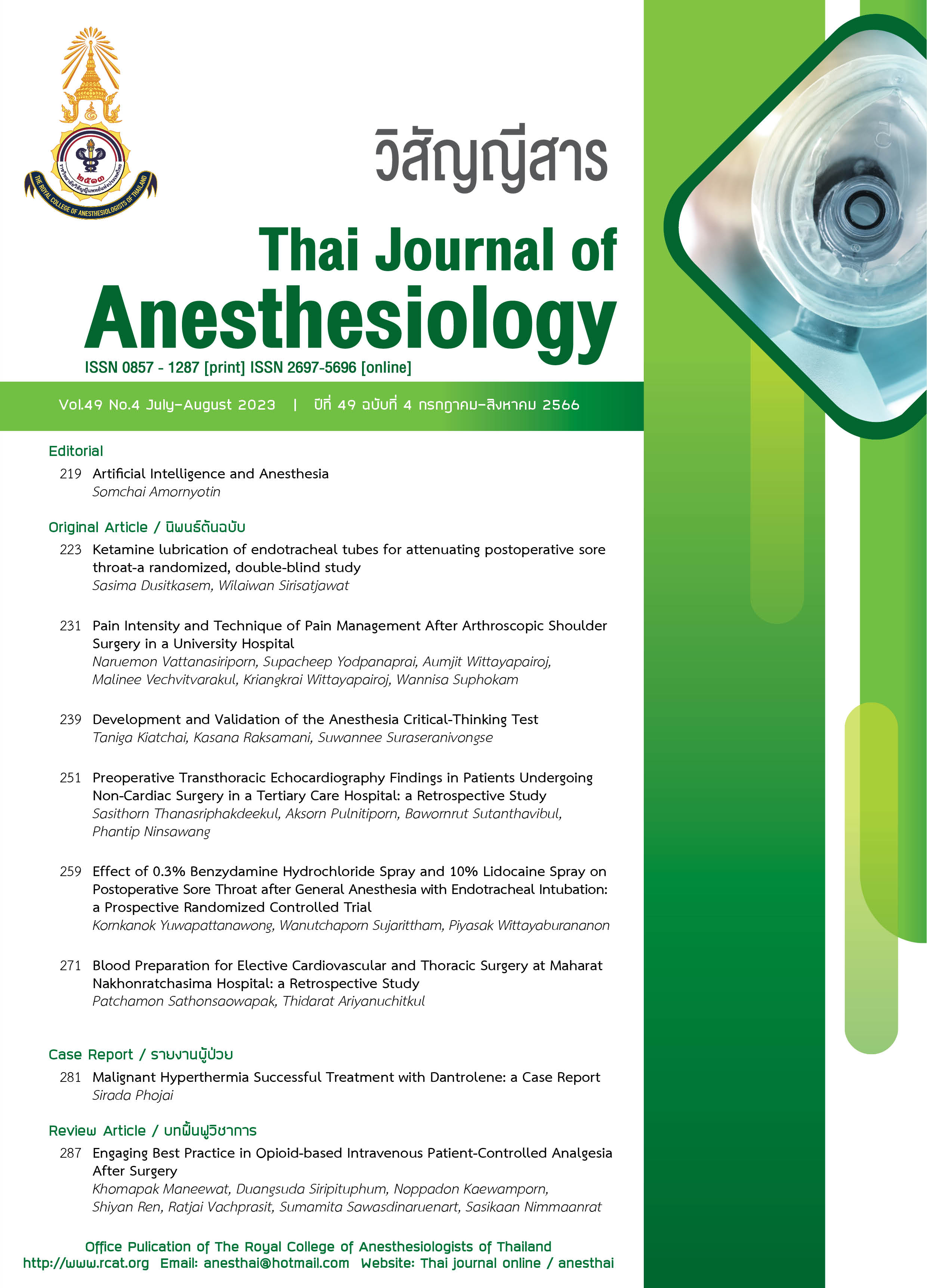Engaging Best Practice in Opioid-based Intravenous Patient-Controlled Analgesia After Surgery
Main Article Content
Abstract
Opioid-based intravenous patient-controlled analgesia (IV-PCA) has been used extensively to relief acute postoperative pain for several decades. Recently, PCA has just been accepted and widely used in Thai hospital context. Here, using PCA is a relatively new method of opioid administration for nurses which specific knowledge and complex skills are required. The purpose of this review was to summarize the best practices in the administration of IV-PCA for patients after surgery. An integrative review method was employed using the search terms and the following databases: PubMed, CINAHL, Cochrane Library, and ThaiJo. Thirteen clinical practice guidelines, a literature review, and a retrospective study published between 2001 and 2021 which met the inclusion criteria were included in the final analysis. The quality of evidence and risk of bias of 13 articles were evaluated by AGREE II and the Joanna Briggs (JBI) institute critical appraisal tools which revealed good data extraction from the 15 included studies was done using the evidence table in accordance to the purpose of this review. Content analysis and narrative synthesis were employed for data analysis and synthesis. This review indicated that administration of IV-PCA best practice involved 5 phases. Phase I before implanting PCA, this phase focused on capability development and accreditation for staff involved in caring for the patients receiving IV-PCA after surgery, readiness of relevant resources, including clinical practice guideline, standard for practices, and policy. Phase II, prior to administration of IV-PCA, this phase involved patient selection, patient education, and opioid risk assessment. Phase III, patients’ pre-commencement of IV-PCA, this phase included verification and validation of PCA prescription, PCA devices, and equipment. Phase IV, patients receiving IV-PCA, this phase highlighted the provision of adequate analgesia, adequate pain relief, prevention of medication error, assessment and management of opioid-induced side effects and complication, including patient monitoring and documentation. The last phase, before and after discontinuation of IV-PCA, assessment of patients’ readiness to discontinue IV-PCA as the certain criteria, receiving new prescription of oral analgesia, ongoing patients’ evaluation, and documentation at least 4 hours after ceasing the IV-PCA. Capability development as well as accreditation of nursing practices are the first step maintaining safety and efficacy of IV-PCA. In-service training in conjunction with contextually-sensitive clinical nursing practice guideline for Thai hospitals are the foreseeable benefits of this review.
Article Details

This work is licensed under a Creative Commons Attribution-NonCommercial-NoDerivatives 4.0 International License.
References
Chen Q, Chen E, Qian X. A narrative review on perioperative pain management strategies in enhanced recovery pathways-the past, present and future. J Clin Med. 2021;10:2568.
Wang H, Sherwood GD, Liang S, et al. Comparison of postoperative pain management outcomes in the United States and China. Clin Nurs Res. 2021;30:1290-300.
Bennett RL, Batenhorst RL, Bivins BA, et al. Patient-controlled analgesia: a new concept of postoperative pain relief. Ann Surg. 1982;195:
-5.
Conner M, Deane D. Patterns of patient-controlled analgesia and intramuscular analgesia. Appl Nurs Res. 1995;8:67-72.
Whittemore R, Knafl K. The integrative review: updated methodology. J Adv Nurs. 2005;52:546-53.
สถาบันวิจัยและประเมินเทคโนโลยีทางการแพทย์ กรมการแพทย์ กระทรวงสาธารณสุข. เครื่องมือการประเมินคุณภาพแนวทางปฏิบัติสําหรับการวิจัยและการประเมินผล (Appraisal of Guideline for Research & Evaluation II; AGREE II), 2556.
McArthur A, Klugárová J, Yan H, Florescu S. Innovations in the systematic review of text and opinion. Int J Evid Based Healthc. 2015;13:188-95.
Moola S, Munn Z, Sears K, et al. Conducting systematic reviews of association (etiology): the Joanna Briggs Institute’s approach. Int J Evid Based Healthc. 2015;13:163-9.
Dang D, Dearholt S. Johns Hopkins nursing evidence-based practice: model and guidelines. 2nd ed. vol. 2012. Sigma Theta Tau International; 2012.
Dyer K. Trust guideline for the management of patient controlled analgesia (PCA) in adults. NHS foundation trust: Norflok and Norwich University Hospitals; 2021.
Medlicott S. Patient controlled analgesia (PCA) adult clinical guideline V9.0. NHS trust: Royal Cornwall Hospitals; 2021.
Lead clinician pain service. Adult patient controlled analgesia (intravenous) clinical practice guidelines. MAIDSTONE AND TUNBRIDGE WELLS NHS TRUST; 2020.
Robinson L. Patient controlled analgesia (PCA). Doncaster and Bassetlaw Hospitals: NHS foundation trust; 2014.
Acute pain lead. Acute pain guidelines: patient controlled analgesia (PCA). Northern Devon Healthcare: NHS trust; 2017.
Pain service team. Management of patient controlled analgesia (PCA) in adults. Buckinghamshire Healthcare NHS Trust; 2021.
Daykin S. Administration of patient controlled analgesia (IV PCA) for patients 16 years and over within an adult environment. University Hospitals of Leicester: NHS trust; 2021.
Local operating procedure-clinical. Patient controlled analgesia (PCA)-intravenous. The Royal Hospital for Women; 2020.
Canberra Hospital and Health Services. Acute pain management techniques: patient controlled analgesia (PCA). Canberra Hospital and Health Services; 2017.
GNMEC. Patient controlled analgesia (PCA) learning package. Nurse & Midwife Education Gippsland; 2021.
Schug SA, Palmer GM, Scott DA, Alcock M, Halliwell R, Mott JF. Acute pain management: scientific evidence. 5th ed. Melbourne: ANZCA & FPM; 2020.
Macintyre PE. Safety and efficacy of patient-controlled analgesia. Brit J Anaesth. 2001;87:36-46.
So KY, Kim SH. Cutoff values for providing the ideal intravenous patient-controlled analgesia according to the intensity of postoperative pain-a retrospective observational study. Medicina. 2021;57:1065.
Canterbury District Health Board. Adult patient controlled analgesia (PCA). Canterbury District Health Board; 2021.
Waitemata Pain Services. Pain management: patient-controlled analgesia. Waitemata District Health Board; 2015.
McNicol ED, Ferguson MC, Hudcova J. Patient controlled opioid analgesia versus non-patient controlled opioid analgesia for postoperative pain. Cochrane Database Syst Rev. 2015;2015(6):CD003348.
Buckinghamshire Healthcare NHS Trust. Management of patient controlled analgesia (PCA) in adults (age 16 years and older) [internet]. 2021. Available from: http://www.bucksformulary.nhs.uk/docs/Guideline_332FM.pdf?UID=92581743820 219120416
Clinical excellence commission. Clinic focus report-patient controlled analgesia [internet]. 2013. Available from: https://www.cec.health.nsw.gov.au/__data/assets/pdf_file/0009/259209/
patient-safety-report-pca-web.pdf
Vaghari, B, Gandhi K, Viscusi E. IV Patient Controlled Analgesia [Internet]. The American Society of Regional Anesthesia and Pain Medicine (ASRA). 2019 [cited 2021 Dec 19]. Available from: https://www.asra.com/news-publications/asra-updates/blog-landing/legacy-b-blog-posts/2019/08/06/iv-patient-controlled-analgesia

